

YouTube. Ear Training Tools. Sight-singing (solfeggio) Music Skills Games - Music and Special Education. Chord and Interval Recognition. Rhythmic ET. Mostly Ear Training. InstruNOTE makes learning music more effective, more affordable, and more fun! Music Notation Training. Identify the Thing you Hear - Level 7 (Anything!!) Identify the Thing you Hear - Level 6 (Jazz Majors - Complex Upper Tertian Harmony) Identify the Thing you Hear - Level 5 (Set Theory Chords / Advanced!!) Identify the Thing you Hear - Level 2 (Inversions, 7th chords, scales, intervals, etc.)
Identify the Thing you Hear - Level 3 (Inversions, Functional chords, Cadences, etc.) Identify the Thing you Hear - Level 4 (Modes, Critical Thinking, Scales, Inversions, 7th Chords, etc.) Identify the Thing you Hear - Level 1 (intervals, scales, triads, etc.) Dolmetsch Online - Music Theory Online - Ear Tests and Drills. Ear Tests and Drills :: For 'clean' or 'blank' manuscript/staff paper (also called score paper) Manuscript/staff paper Ear test and drill resources, maintained off the Music Theory Online site, we believe to be accurate but we are not responsible for any errors.

Sites that give helpful hints about how to approach acquiring aural skills, although no actual exercises are included. www.wmich.edu/mus-theo/etg/et_guide.html - David Loberg's Aural Comprehension Site Robert Kelly's Guide to Ear Training [our thanks to Chris Buck for spotting a change of URL] Tools and resources on the Practicespot Web Site. Integrated Aural Skills. Welcome Introduction to Aural Skills Introduction to Intervals.
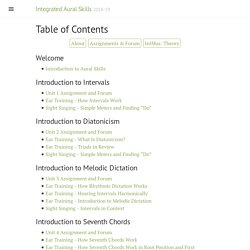
Music Theory for Non-Music Majors II. Ear Training/Dictation for Music Majors. Ear Training Sites: There are two ear training sites that you can work with.
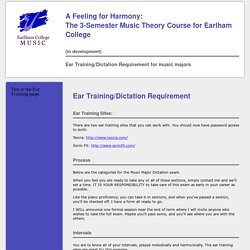
You should now have password access to both: Teoria: Sonic Fit: Process Below are the categories for the Music Major Dictation exam. When you feel you are ready to take any or all of these sections, simply contact me and we'll set a time. Like the piano proficiency, you can take it in sections, and when you've passed a section, you'll be checked off. I WILL announce one formal session near the end of term where I will invite anyone who wishes to take the full exam.
School of Music. ABRSM: Mock aural tests. A single set of mock tests for each grade, taken from ABRSM’s Specimen Aural Tests volumes, is available from this website as a free audio download, to help prepare candidates for what to expect in the exam.
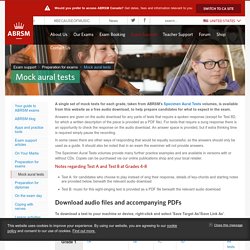
Answers are given on the audio download for any parts of tests that require a spoken response (except for Test 8D, for which a written description of the piece is provided as a PDF file). For tests that require a sung response there is an opportunity to check the response on the audio download. An answer space is provided, but if extra thinking time is required simply pause the recording. In some cases there are other ways of responding that would be equally successful, so the answers should only be used as a guide. It should also be noted that in an exam the examiner will not provide answers. The Specimen Aural Tests volumes provide many further practice examples and are available in versions with or without CDs. Notes regarding Test A and Test B at Grades 4-8. About Music Education - Gary Karpinski.
FREE! Ear Training Software · Joe Hubbard Bass. Please follow these instructions to download the software:1.

Click DOWNLOAD NOW 2. A window should appear that prompts you to either Open or Save the program; click “Save” 3. Another window should appear where you can assign where you want to save the file, for example: your Desktop; assign location where you want to save the file and then click “Save” 4. It comes in a Zip File called FET_Basic_Setup 5. Double Click on the Zip File and double click the “Setup” file 6. System Requirements: Windows 98/ME/NT/2000/XP/Vista/Windows 7Minimum 64 MB of RAMMinimum 10 MB free disk spaceSoundcard or MIDI device This software is only available as a Microsoft Windows executable. If you have any further questions, please contact me at: heyjoe@joehubbardbass.com. John Murphy - ear training interview. Following is an interview I conducted with John Murphy, a professor in the jazz studies program at the University of North Texas (UNT).
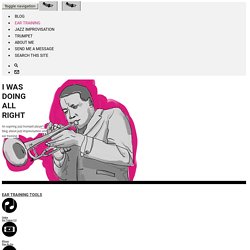
As you'll read below, the interview focuses on his thoughts about ear training and its role in jazz education at UNT. I really value John's insight and would like to thank him for his contribution to this website and, more importantly, to jazz education. Thanks, John! And now, on to the interview… Q: What classes do you teach at UNT? A: These are the courses I teach regularly: jazz aural fundamentals, undergrad and graduate jazz history, graduate jazz analysis and research methods, Jazz Repertory Ensemble.
Q: Please tell us a little about the required ear training classes for undergraduate jazz studies majors at UNT. Kent1216237008. Hear More: Basic Ear Training for Musicians. SonicFit. Sight singing is the ability to sing musical notation without the aid of an instrument.
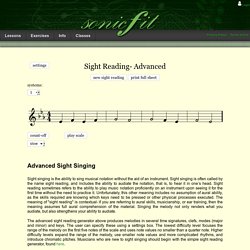
Sight singing is often called by the name sight reading, and includes the ability to audiate the notation, that is, to hear it in one’s head. Sight reading sometimes refers to the ability to play music notation proficiently on an instrument upon seeing it for the first time without the need to practice it. Unfortunately, this other meaning includes no assumption of aural ability, as the skills required are knowing which keys need to be pressed or other physical processes executed. The meaning of "sight reading" is contextual- if you are referring to aural skills, musicianship, or ear training, then the meaning assumes full aural comprehension of the material. Singing the melody not only renders what you audiate, but also strengthens your ability to audiate. The advanced sight reading generator above produces melodies in several time signatures, clefs, modes (major and minor) and keys. Other exercises. Ear training online and mobile.
Mimicopy.com — Problems of Music Dictation — Home. Syllabus AP MusicTheory. Complete Ear Trainer – The ultimate ear training app for musicians. Practice Music Theory & Ear Training Exercises.
SonicFit- Exercises for Ear Training and Aural Skills. Ear Training and Aural Skills Exercises Ear training exercises help to develop a musicians aural skills and musicianship.
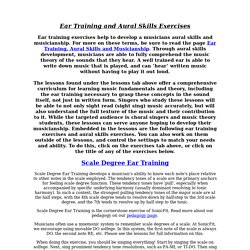
For more on these terms, be sure to read the page Ear Training, Aural Skills and Musicianship. Through aural skills development, musicians are able to fully comprehend the music theory of the sounds that they hear. A well trained ear is able to write down music that is played, and can ‘hear’ written music without having to play it out loud. The lessons found under the lessons tab above offer a comprehensive curriculum for learning music fundamentals and theory, including the ear training necessary to grasp these concepts in the sound itself, not just in written form. SonicFit- Exercises for Ear Training and Aural Skills. Ear Training and Aural Skills Exercises Ear training exercises help to develop a musicians aural skills and musicianship.
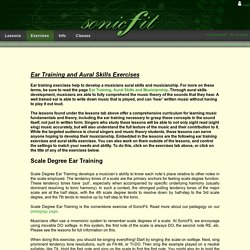
For more on these terms, be sure to read the page Ear Training, Aural Skills and Musicianship. Through aural skills development, musicians are able to fully comprehend the music theory of the sounds that they hear. 5a1 5.TAhandbook1112. Improhub. Elementary Aural Skills Placement Examination. This examination tests general knowledge and skills in the area of aural skills.
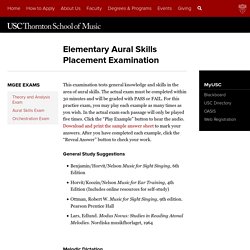
The actual exam must be completed within 30 minutes and will be graded with PASS or FAIL. For this practice exam, you may play each example as many times as you wish. In the actual exam each passage will only be played five times. Click the “Play Example” button to hear the audio. Download and print the sample answer sheet to mark your answers.
General Study Suggestions. Study guide. Drum Machine - Play Free Online Games. Music Quizzes, Games, Pianos, Worksheets. Music Quizzes, Games, Worksheets and Music Theory by Ms. Garrett Scroll down the page to play elementary and middle school level quizzes, puzzles and games about music notes, rhythms, instruments, composers, and more. PLEASE NOTE: I have already updated 60 of the quizzes below, along with the rest of my site. Please update your links, as many of the quiz links have changed. Some of the FLASH quizzes were made with software that is no longer produced, so it will not be possible to update those games for mobile devices.
Theta Music Trainer: Ear Training and Music Theory. GCSE Music Revision - Melodic Dictation. GCSE Music Revision - Melodic Dictation Part 2. Introduction to Transcribing Music. 1. What Does it Mean to Transcribe Music? What I am talking about here is the process of working out how to play and/or write out a piece of music starting with just a recording of the piece - a commercially released CD perhaps.
Transcribe! - software to help transcribe recorded music. The Transcribe! Application is an assistant for people who want to work out a piece of music from a recording, in order to write it out, or play it themselves, or both. It doesn't do the transcribing for you, but it is essentially a specialised player program which is optimised for the purpose of transcription. It has many transcription-specific features not found on conventional music players. It is also used by many people for play-along practice.
Piano Blog. Ear Training - Hooktheory. WMU - Aural Skills Guide. Grade 1 Challenge part 18: ABRSM group B songs. Hathi Trust Digital Library. Hathi Trust Digital Library. James Woodward. Aural Training Grades 1 - 8. Musicwithnopain. Solfège. Ear Training - Hooktheory.
Open software for music theory. Welcome to LenMus! It is a free open software project, committed to the principles of open source software, free education, and open access to information. It has no commercial purpose. ET Dictations. WMU - Aural Skills Guide. Ear Training Books. Harmony and ear-training, by William Alfred White. Educational vocal studies : a method of elementary.
Melodia : a comprehensive course in sight-singing. Ear training and sight singing. Applied to elementary. Scrolling scores sorted by scale. Sheet Music.